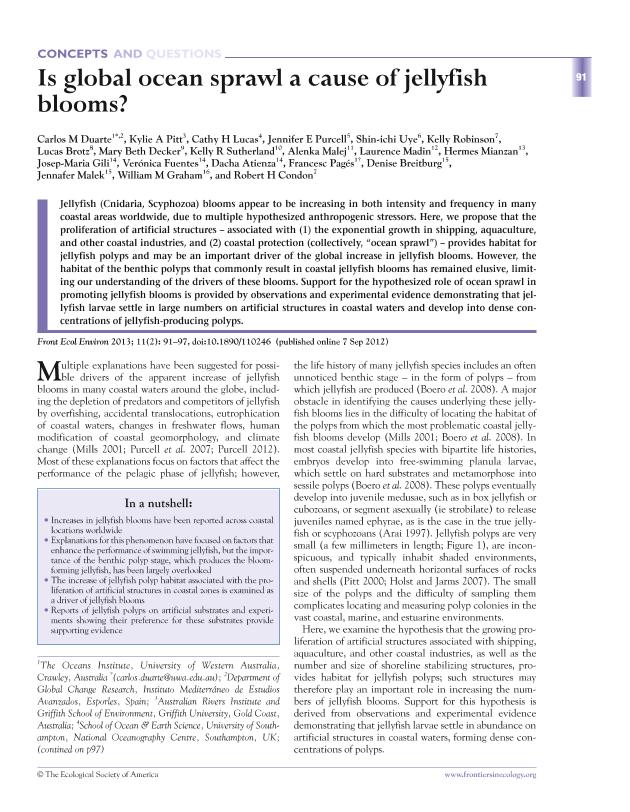Artículo
Is global ocean sprawl a cause of jellyfish blooms?
Duarte, Carlos M.; Pitt, Kylie A.; Lucas, Cathy H.; Purcell, Jennifer E.; Uye, Shin-ich; Robinson, Kelly; Brotz, Lucas; Decker, Mary Beth; Sutherland, Kelly R; Malej, Alenk; Madin, Laurence; Mianzan, Hermes Walter ; Gili, Josep-Maria; Fuentes, Verónica Lorena
; Gili, Josep-Maria; Fuentes, Verónica Lorena ; Atienza, Dacha; Pagés, Francesc; Breitburg, Denise; Malek, Jennafer; Graham, William M; Condon, Robert H.
; Atienza, Dacha; Pagés, Francesc; Breitburg, Denise; Malek, Jennafer; Graham, William M; Condon, Robert H.
 ; Gili, Josep-Maria; Fuentes, Verónica Lorena
; Gili, Josep-Maria; Fuentes, Verónica Lorena ; Atienza, Dacha; Pagés, Francesc; Breitburg, Denise; Malek, Jennafer; Graham, William M; Condon, Robert H.
; Atienza, Dacha; Pagés, Francesc; Breitburg, Denise; Malek, Jennafer; Graham, William M; Condon, Robert H.
Fecha de publicación:
02/2013
Editorial:
Ecological Society of America
Revista:
Frontiers in Ecology and the Environment
ISSN:
1540-9295
Idioma:
Inglés
Tipo de recurso:
Artículo publicado
Clasificación temática:
Resumen
Jellyfish (Cnidaria, Scyphozoa) blooms appear to be increasing in both intensity and frequency in many coastal areas worldwide, due to multiple hypothesized anthropogenic stressors. Here, we propose that the proliferation of artificial structures – associated with (1) the exponential growth in shipping, aquaculture, and other coastal industries, and (2) coastal protection (collectively, “ocean sprawl”) – provides habitat for jellyfish polyps and may be an important driver of the global increase in jellyfish blooms. However, the habitat of the benthic polyps that commonly result in coastal jellyfish blooms has remained elusive, limiting our understanding of the drivers of these blooms. Support for the hypothesized role of ocean sprawl in promoting jellyfish blooms is provided by observations and experimental evidence demonstrating that jellyfish larvae settle in large numbers on artificial structures in coastal waters and develop into dense concentrations of jellyfish-producing polyps.
Palabras clave:
Jellyfish Blooms
,
Increase
,
Polyps
,
Artificial Substrate
Archivos asociados
Licencia
Identificadores
Colecciones
Articulos(CCT - MAR DEL PLATA)
Articulos de CTRO.CIENTIFICO TECNOL.CONICET - MAR DEL PLATA
Articulos de CTRO.CIENTIFICO TECNOL.CONICET - MAR DEL PLATA
Articulos(IIMYC)
Articulos de INSTITUTO DE INVESTIGACIONES MARINAS Y COSTERAS
Articulos de INSTITUTO DE INVESTIGACIONES MARINAS Y COSTERAS
Citación
Duarte, Carlos M.; Pitt, Kylie A.; Lucas, Cathy H.; Purcell, Jennifer E.; Uye, Shin-ich; et al.; Is global ocean sprawl a cause of jellyfish blooms?; Ecological Society of America; Frontiers in Ecology and the Environment; 11; 2; 2-2013; 91-97
Compartir
Altmétricas



